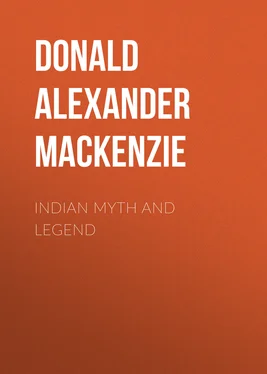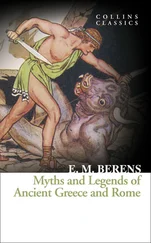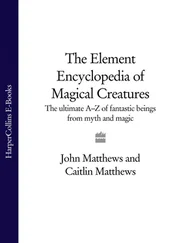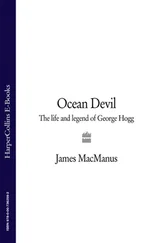Donald Alexander Mackenzie - Indian Myth and Legend
Здесь есть возможность читать онлайн «Donald Alexander Mackenzie - Indian Myth and Legend» — ознакомительный отрывок электронной книги совершенно бесплатно, а после прочтения отрывка купить полную версию. В некоторых случаях можно слушать аудио, скачать через торрент в формате fb2 и присутствует краткое содержание. Жанр: foreign_prose, foreign_religion, Философия, Мифы. Легенды. Эпос, foreign_psychology, foreign_antique, на английском языке. Описание произведения, (предисловие) а так же отзывы посетителей доступны на портале библиотеки ЛибКат.
- Название:Indian Myth and Legend
- Автор:
- Жанр:
- Год:неизвестен
- ISBN:нет данных
- Рейтинг книги:4 / 5. Голосов: 1
-
Избранное:Добавить в избранное
- Отзывы:
-
Ваша оценка:
- 80
- 1
- 2
- 3
- 4
- 5
Indian Myth and Legend: краткое содержание, описание и аннотация
Предлагаем к чтению аннотацию, описание, краткое содержание или предисловие (зависит от того, что написал сам автор книги «Indian Myth and Legend»). Если вы не нашли необходимую информацию о книге — напишите в комментариях, мы постараемся отыскать её.
Indian Myth and Legend — читать онлайн ознакомительный отрывок
Ниже представлен текст книги, разбитый по страницам. Система сохранения места последней прочитанной страницы, позволяет с удобством читать онлайн бесплатно книгу «Indian Myth and Legend», без необходимости каждый раз заново искать на чём Вы остановились. Поставьте закладку, и сможете в любой момент перейти на страницу, на которой закончили чтение.
Интервал:
Закладка:
1
Photo. Johnson and Hoffmann
THE CREMATION GHAT, BENARES
It seems reasonable to suppose that the cremation rite originated among a nomadic people. The spirits of the dead were got rid of by burning the body: they departed, like the spirit of Patroklos, after they had received their “meed of fire”. Burial sites were previously regarded as sacred because they were haunted by the spirits of ancestors (the Indian Pitris = “fathers”). A people who burned their dead, and were therefore not bound by attachment to a tribal holy place haunted by spirits, were certainly free to wander. The spirits were transferred by fire to an organized Hades, which appears to have been conceived of by a people who had already attained to a certain social organization and were therefore capable of governing the communities which they subdued. When they mingled with peoples practising other rites and professing different religious beliefs, however, the process of racial fusion must have been accompanied by a fusion of beliefs. Ultimately the burial customs of the subject race might prevail. At any rate, this appears to have been the case in Britain, where, prior to the Roman Age, the early people achieved apparently an intellectual conquest of their conquerors; the practice of the cremation rite entirely vanished.
We have gone far afield to find a clue to assist towards the solution of the Aryan problem in India. The evidence accumulated is certainly suggestive, and shows that the conclusions of the early philologists have been narrow in the extreme. If the long-headed Kurds are, as Ripley believes, the descendants of the Mitanni raiders, then the Aryans of history must be included in the Brown race. As, however, cremation was not practised by the Berbers, the Babylonians, the early Cretans, or other representatives of the ancient brunet dolichocephalic peoples, it may be that the custom, which still lingers among the Mongolian Buriats, was not in the narrow sense of Aryan origin. It may have been first practised among an unknown tribe of fire-worshippers, who came under the influence of a great teacher like Zoroaster. We cannot overlook in this connection the possibility of an individual origin for a new and revolutionary system of religious doctrines. Buddhism, for instance, originated with Buddha.
As we have said, the Vedic religion of the Aryans in India was characterized by the worship of male deities, the goddesses being of secondary and even slight importance. A religious revolution, however, occurred during the second or Brahmanical Age—the age of priestly ascendancy. Fresh invasions had taken place and the Aryans were divided into tribal groups of Westerners and Easterners, on either side of a central power in Madhyadesa, the “Middle Country” which extended between the upper reaches of the Saraswati and the Ganges and the Jumna rivers. The Westerners included the peoples of the Punjab and the north-western frontier, and the Easterners the kingdoms of Kasi (Benares) and Maghadha as well as Kosala and Videha, which figure prominently in the Ramáyana epic, where the kings are referred to as being of the “Solar race”. The Middle Kingdom was the centre of Brahmanical culture and influence: it was controlled by those federated tribes, the Kuru Panchalas, with whom were fused the Bháratas of the “Lunar race”. It is believed that the military aristocracy of the “Middle Country” were late comers who arrived by a new route and thrust themselves between the groups of early settlers. 34The Bharatas worshipped a goddess Bharati who was associated with the Saraswati river on the banks of which the tribe had for a period been located. Saraswati became the wife of Brahma, the supreme god, and it would seem that she had a tribal significance.
If the Bharatas of the “Lunar race” worshipped the moon and rivers, it is possible that they belonged to the Brown race. The folk-religion of the tribe would be perpetuated by the people even although their priests became speculative thinkers like the unknown authors of the Upanishads . It is significant to note, therefore, that the goddesses ultimately came into as great prominence in India as in Egypt. This change took place during the obscure period prior to the revival of Brahmanism. In the sixth century before the Christian era Buddhism had origin, partly as a revolt of the Kshatriya (aristocratic) class against priestly ascendancy, and the new faith spread eastward where Brahmanic influence was least pronounced. When the influence of Buddhism declined, the Pantheon is found to have been revolutionized and rendered thoroughly Mediterranean in character. The Vedic gods had in the interval suffered eclipse; they were subject to the greater personal gods Brahma, with Vishnu and Shiva, each of whom had a goddess for wife. Brahma, as we have said, had associated with him the river deity Saraswati of the Bharatas; the earth goddess, Lakshmi, was the wife of Vishnu; she rose, however, from the Ocean of Milk. But the most distinctive and even most primitive goddesses were linked with Shiva, the Destroyer. The goddess Durga rivalled Indra as a deity of war. Kali, another form of Durga, was as vengeful and bloodthirsty as the Scottish Cailleach, or the Egyptian Hathor, who, as the earlier Sekhet, rejoiced in accomplishing the slaughter of the enemies of Ra. 35Kali, as we shall see ( Chapter VIII) replaced the Vedic king of the gods as a successful demon slayer. As the Egyptian Ra went forth to restrain Hathor, so did Shiva hasten to the battlefield, flooded by gore, to prevail upon his spouse Kali to spare the remnant of her enemies.
2
KALI
From a bronze in the Calcutta Art Gallery
The rise of the goddesses may have been due in part to the influence of Dravidian folk-religion. This does not, however, vitiate the theory that moon, water, and earth worship was not unconnected with the ascendancy of the Brown race in India. The Dravidian brunet long heads were, as we have said, probably represented in the pre-Aryan, as well as the post-Vedic folk-waves, which mingled with pre-Dravidian stocks. Mr. Crooke inclines to the view that the Aryan conquest was more moral and intellectual than racial. 36The decline of the patriarchal religion of the Vedic military aristocracy may thus be accounted for; the religious practices of the earlier people might ultimately have attained prominence in fusion with imported ideas. If the Aryan racial type was distinctive, as it appears to have been, in colour at any rate, the predominant people who flourished when the hymns were composed, may have greatly declined in numbers owing to the ravages of disease which in every new country eliminates the unfit in the process of time. Even if Aryan conquest was more racial in character than Mr. Crooke will allow, the physical phenomena of the present day can be accounted for in this way, due allowance being made, of course, for the crossment of types. In all countries which have sustained the shock of invasion, the tendency to revert to the aboriginal type is very marked. At any rate, this is the case in Egypt and Crete as present-day evidence shows. In Great Britain, which was invaded by the broad heads of the Bronze Age, the long-headed type is once again in the majority; a not inconsiderable proportion of our people show Stone Age (Mediterranean) physical characteristics.
In this connection it is of interest to refer to immemorial beliefs and customs which survive in representative districts in Britain and India where what may be called pre-Aryan influences are most pronounced. A people may change their weapons and their language time and again, and yet retain ancient modes of thought. In Devon, which the philologists claim to be largely Celtic like Cornwall, the folk-lore shows marked affinities with that of Ireland, Wales, and Scotland, suggesting the survival of ancient Mediterranean racial influence, for much of what we call Celtic links with what belongs to ancient Greece and the Egyptian Delta. Mr. Gomme has shown 37in an interesting summary of recorded folk-practices that the “ram feast” of Devon resembles closely in essential details similar ceremonies in ancient Greece and modern India. At the beginning of May the people of Devon were wont to sacrifice a ram lamb to the deity of waters. The animal was tied to a pillar, its throat was cut, and young men scrambled to obtain pieces of its flesh for girls. The devourer was assured of good luck during the year. After the ceremony, dancing, wrestling, and drinking were indulged in. A comparison is drawn between this and similar rites among the ancient Semites and ancient Greeks. In India a Dravidian Paria acts as the temporary village priest. He uses a whip like the “gad whip” in Lincolnshire, and kills the lamb by tearing its throat with his teeth. A scramble takes place for the flesh, the people circulate the village, as some communities in our own country still perpetuate the ceremony of “riding the marches” of ancient burghs; then universal licence prevails. Similarly law was suspended at the ancient Scottish Hallowe'en celebrations; in some districts even in our own day Hallowe'en and New Year practical jokes and rowdyism is still prevalent. Herodotus refers to the universal licence and debauchery which characterized the Isis festival in Egypt.
Читать дальшеИнтервал:
Закладка:
Похожие книги на «Indian Myth and Legend»
Представляем Вашему вниманию похожие книги на «Indian Myth and Legend» списком для выбора. Мы отобрали схожую по названию и смыслу литературу в надежде предоставить читателям больше вариантов отыскать новые, интересные, ещё непрочитанные произведения.
Обсуждение, отзывы о книге «Indian Myth and Legend» и просто собственные мнения читателей. Оставьте ваши комментарии, напишите, что Вы думаете о произведении, его смысле или главных героях. Укажите что конкретно понравилось, а что нет, и почему Вы так считаете.












